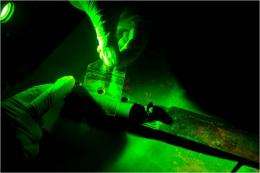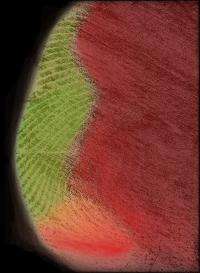Pinpointing accuracy: Research helps solidify evidence in court

Do you know what all of your fingerprints look like? Would you be able to tell whether the pattern of ridges and valleys on a fingerprint was made by you or by someone else? If so, you might have what it takes to be a fingerprint examiner.
In courts throughout the world for the past hundred years, fingerprint experts have been deciding whether or not a print collected at a crime scene matches that of the person suspected of the crime. But in the U.S. adversarial court system, the opinion of fingerprint examiners has often been challenged over the past two decades by the lawyer for the accused person.
While it is commonly agreed that fingerprints taken under controlled conditions from any given individual are unique, the problem is that crime-scene prints are messy. They often are smeared; distorted; covered in blood, dust, or sweat; or are only partial pictures of a pattern on a small part of a finger. Currently, examiners report with absolute certainty that the crime-scene fingerprint was made by the accused person; this claim increasingly is being challenged. Defense attorneys argue that examiners' opinions are not scientifically supported and they attempt to have this clue rejected by judges in U.S. courts.
Now, with support from the U.S. Department of Justice, a Penn State scientist is working to strengthen the scientific foundations of fingerprints for the benefit of the U.S. justice system. Cedric Neumann, an assistant professor of forensic science and statistics, is developing a new analysis technique that will help examiners to grade the quality of crime scene fingerprints and calculate the probability that a crime scene print was made by a suspect.
"We're developing a statistical analysis tool that will help fingerprint examiners show that their expert decisions that a specific person made a specific print are supported by scientific data," Neumann said. The probability calculation enabled by the new tool is an additional factor strengthening the fingerprint examiner's expert testimony.
One of Neumann's innovations is to analyze the geometric measurements of individual features in the patterns of a fingerprint. "We analyze the same features that a fingerprint examiner would study, but we're extracting measurements from those features; for example, how far one feature is from another," he said. "We are organizing all these measurements in a logical way so we can study their statistical distribution and calculate the probability that the two fingerprints came from the same person."

The data-driven system that Neumann is developing measures the geographical relationships between all the features. It also gives different weights to the many types of features and patterns, depending on how common or rare they are. "Some features may be worth more or less, depending on if they are a more common arrangement or a very rare organization," he said.
The new technique also produces a color-coded image of the print that a fingerprint examiner can use as a guide when comparing the crime scene print with the crime suspect's fingerprint. A red color covers the area of the fingerprint that is of such poor quality that the fingerprint examiner should not even look at it. Orange marks an area where the quality is good enough for the examiner to use with caution. Green marks high-quality areas of the fingerprint that the expert can examine with confidence.
Data produced by Neumann's system was used in U.S. courts in 2008 and 2011 to support the admissibility of fingerprint evidence; and was welcomed by the judges.
"The results so far have shown that our probability analysis process is working, so we want to continue making more improvements," Neumann said. "A report from the U.S. National Academy of Sciences in 2009 requires forensic evidence be supported by scientific data."
The next step for Neumann's research, he said, is to investigate how best to provide the statistical information to members of a jury so they will understand it and can use it to assess the evidence in a fair way, whether it is for the prosecution or the defense. This new project is supported by the National Institute of Standards and Technology from the U.S. Department of Commerce and is being performed in partnership with the Penn State Dickinson School of Law and SciLaw-Forensics Ltd., of State College.
"We are using a multidisciplinary approach to validate this project scientifically so that it will be accepted by the scientific community and the legal community, and so it can be used widely as a useful tool in the legal system," Neumann said.
Provided by Pennsylvania State University

















